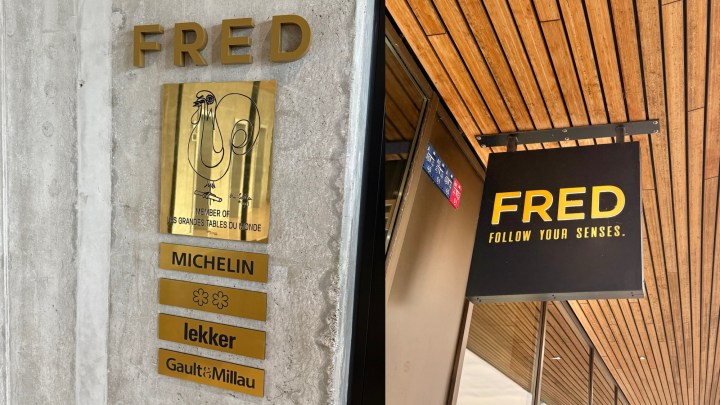
With so many great restaurants close by in Amsterdam, we don’t venture to other parts of the Netherlands as often for fine dining — except of course for our annual visit to the Librije. This is also because if we are going to stay in a hotel after dinner, we might as well go to a three star restaurant abroad (as the Librije is currently the only restaurant in the Netherlands with three stars). According to Michelin, a three star restaurant is worth the journey. Every year for our wedding anniversary I surprise Kees, and we’ve been to places like Copenhagen, Stockholm, Wolfsburg, Girona, or Naples. But this year I thought we’d stay close and go somewhere with a lot of water and boats for Kees to enjoy. And so Rotterdam was our surprise destination, the second largest city of the Netherlands, but our first trip to visit Rotterdam together even though it is only an hour away.
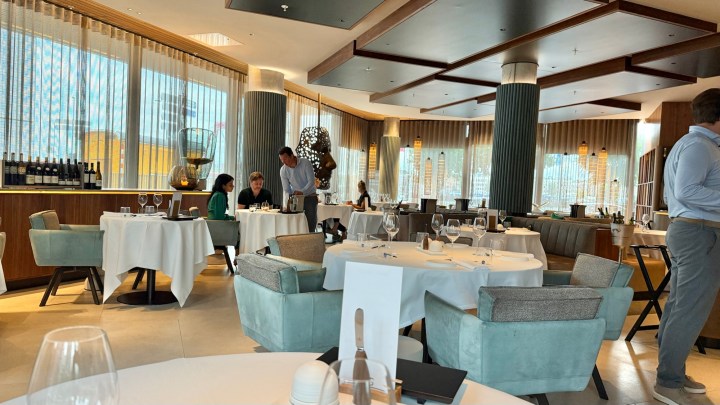
I had booked us a table at restaurant Fred of chef Fred Mustert, which has held two Michelin stars since 2014. The regular tasting menu is 210 euros for 5 courses, but upgraded with an additional course and cheese instead of dessert, we ended up at 285 euros. The regular wine pairing is 97.50 euros and there is a ‘prestige’ pairing for 250 euros. There are three wine lists: white, red, and Burgundy. Since there was such a wide selection of Burgundy and a white Burgundy would go well with the first courses of the tasting menu, we decided to pick a nice bottle and thus ended up with a custom pairing that came out at almost the same price as the prestige pairing.
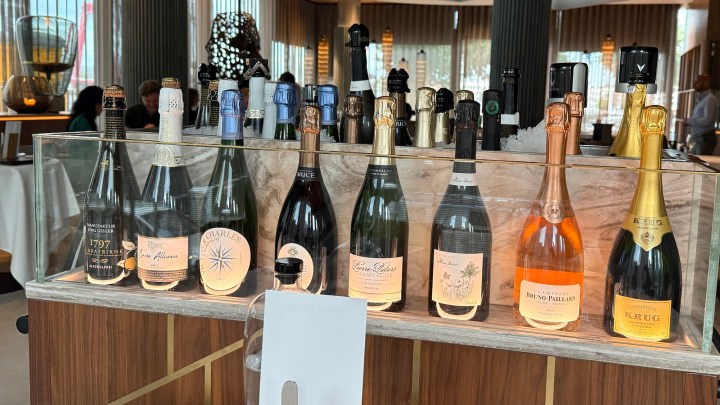
But first we had a glass of champagne from the champagne cart, a Bruno Paillard Première Cuvée Rosé. It is mostly made of Pinot Noir with a bit of Chardonnay, with reserve wines from 25 vintages, and aged for 3 years on the lees.
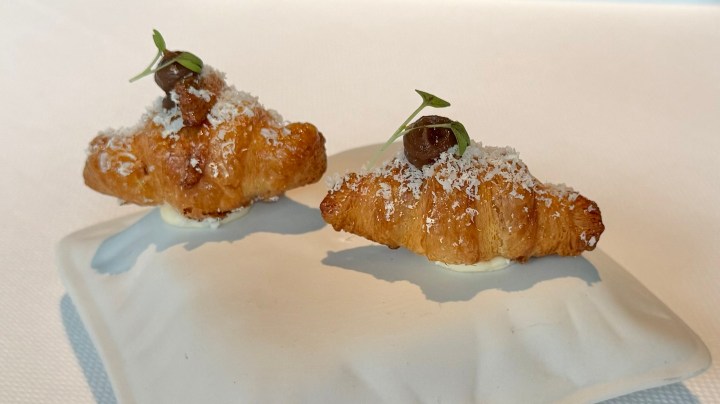
The first amuse bouche was a croissant stuffed with old Rotterdam cheese.
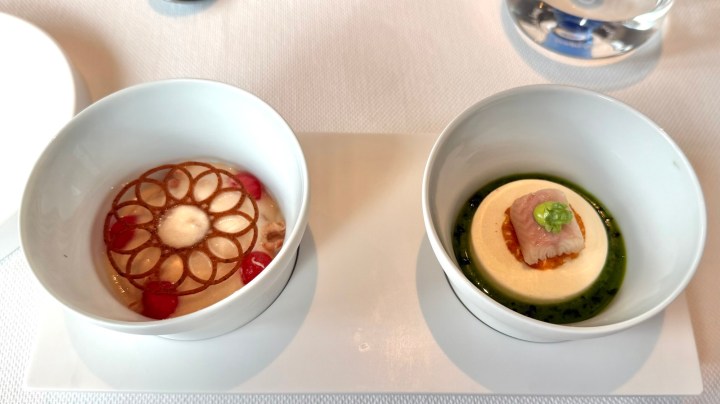
The second and third amuse bouche were Dutch shrimp with watermelon and smoked eel with a cucumber dressing.
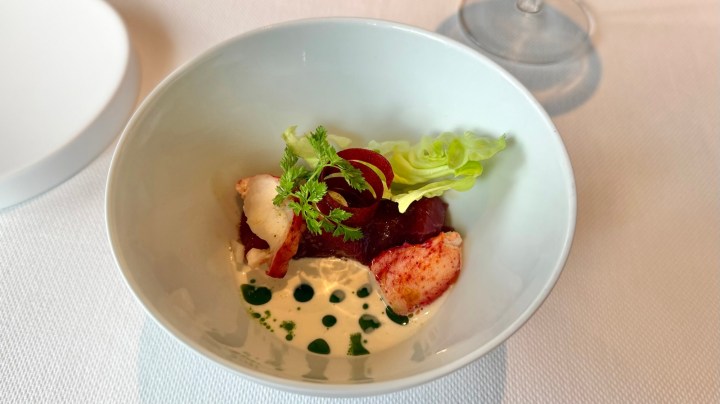
The final amuse bouche was very nice and large enough to be considered a first course of the tasting menu: lobster and raw tuna with a dressing.
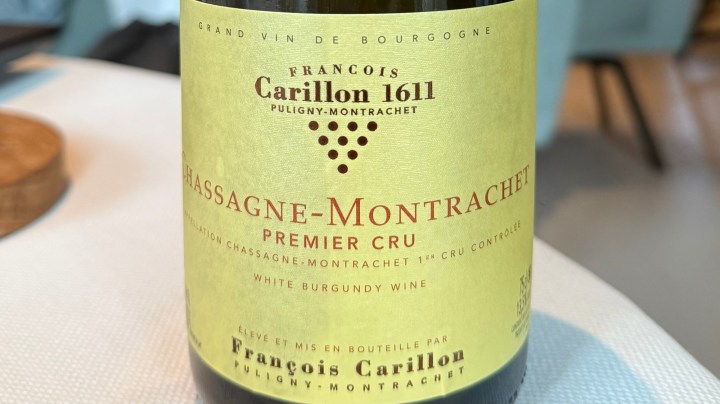
Choosing a nice bottle of Burgundy is no easy task, as even if you know the general characteristics of the appellations and vintages like I do. You really need to know the producers as well to know what to expect. I recently ordered a bottle of Meursault in a restaurant that ended up being more like a Chablis (austere and chalky) than the buttery rich Meursault I was expecting, and so you really need the sommelier to help you navigate the wine list. Well, sommelier Daniël Gravesteijn did a very good job. He knew enough of the characteristics of the many Burgundian wines on the list to help me pick out the Chassagne-Montrachet Premier Cru 2016 by François Carillon that did meet my expectations. It was nicely aged, balanced, and sufficiently rich and complex. (It did develop in the glass and if you happen to have a bottle lying around, I would advice to open it soon as I don’t think it will benefit from additional cellaring.)
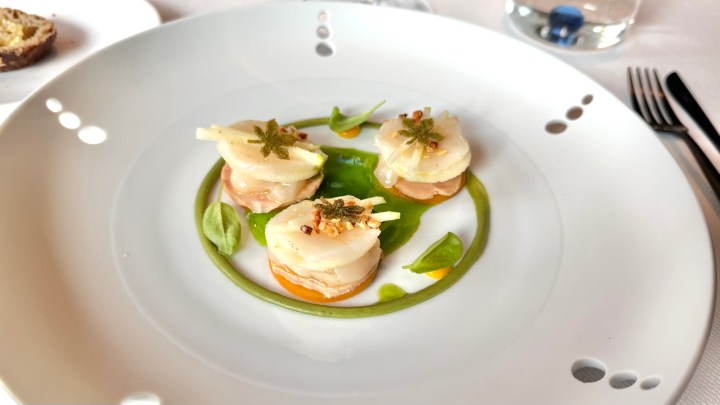
The first course of the menu was raw scallops with foie gras, apple, and avocado. Very elegant in flavor, with the apple slightly overpowering the scallop. Good pairing with the Chassagne.
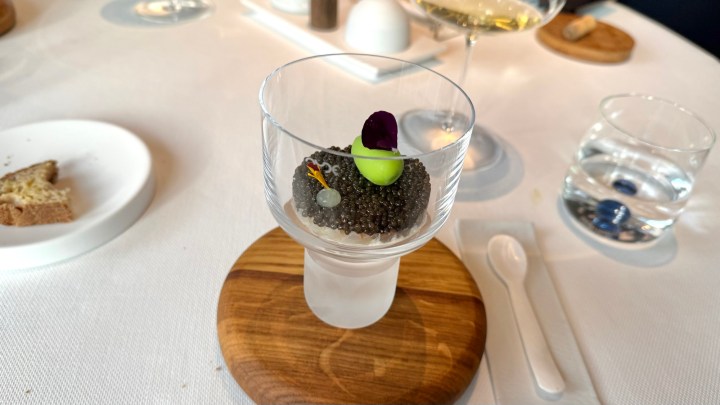
Next was hamachi tartare with Oscietra caviar, crème fraîche, and an ‘olive’. You can’t go wrong with hamachi and caviar (again a good pairing with the Chassagne), but we both thought the sweetish ‘olive’ could have been missed (and messed with the wine).

We had discussed the pairing with the sommelier and he suggested we pair something else with the third course. We decided to have half glasses of the regular pairing for this dish, a white Rioja, and the premium pairing, a Pícaro del Aguila Viñas Viejas Clarete 2022 from Ribera del Duero (Spain). The latter is a field blend of many different red and white grape varieties, with Tempranillo and Albillo the most important ones. All the grape varieties are cofermented together and aged for 16 months in oak barrels. It is called “Clarete” (claret) rather than rosé and it has a darker color than the popular rosé from Provence. The wine had great body, aroma, balance, and complexity.
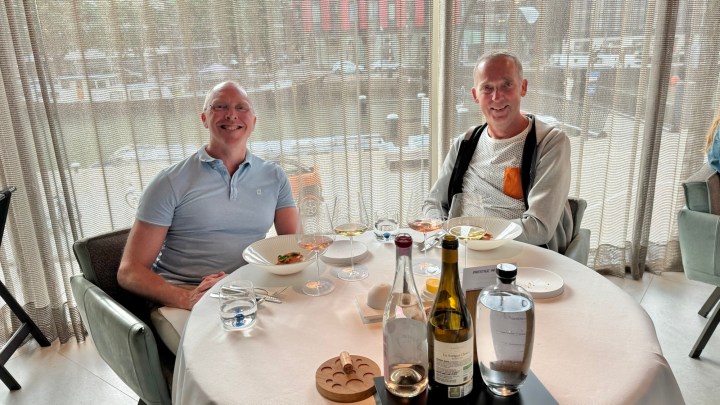
We had the two wines side by side, so it was just like a wine dinner at home in that respect.
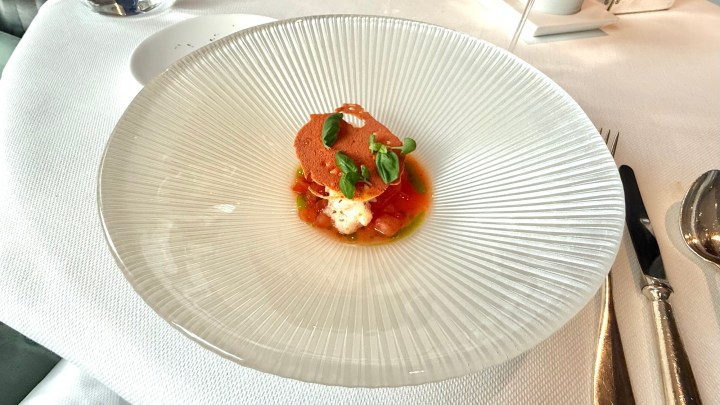
The clarete was a perfect pairing for the langoustine with “Amela” tomato and basil. The dish had a delicious full tomato flavor and it was very good advice not to try and pair this with the Chassagne. In fact, the pairing with the white Rioja from the regular wine pairing didn’t really work either. With a perfectly cooked langoustine, the wonderful tomato flavor, and the delicious pairing, this was our favorite dish of the evening.

We finished the Chassagne with the next dish, which was a great pairing because of the beurre blanc sauce. It was sea bass topped with a slice of turnip, which was in turn topped with stripes of lardo and smoked beef, served with white asparagus, and young garden peas. The fish was quite firm (almost overcooked), so the beurre blanc was really needed to compensate for that. It was a nice dish, the peas and asparagus were perfect. But it would have been even better with the sea bass less cooked, without the turnip, and with a larger amount of lardo and smoked beef to be able to include them with every bite of fish.

We continued with a 2017 Brunello di Montalcino by Le Chiuse, a very nice Brunello (Sangiovese, Tuscany, Italy) aged for 3 years in large oak barrels. Brunello can be very tannic when it is still young, but this was ready to drink and very enjoyable.
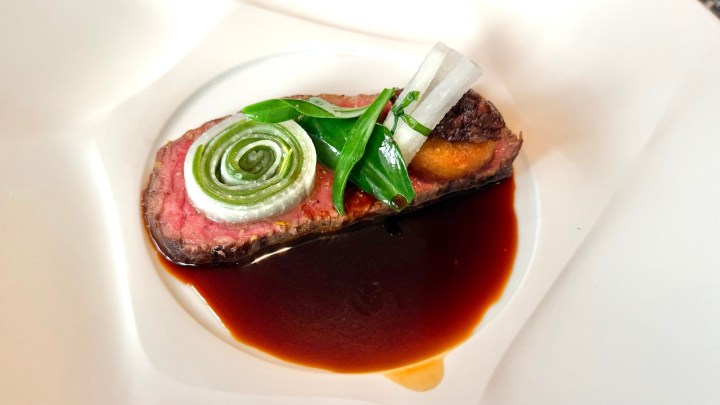
It was a good pairing for the Australian Wagyu with a beef and Mirin jus and shallots. The jus was a bit thin (both in consistency and in flavor) and the beef was not very tender and not as flavorful as Wagyu can be.
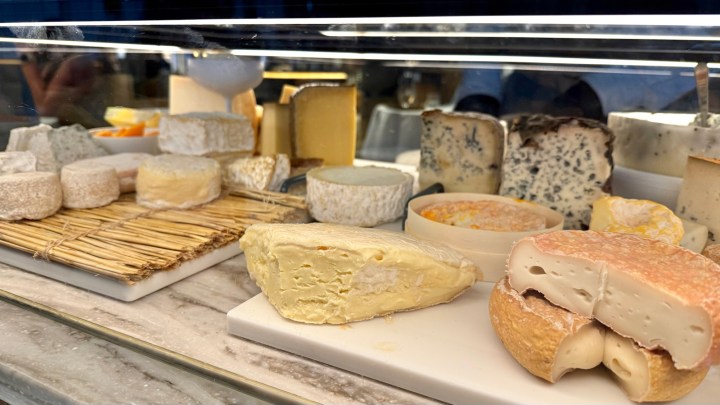
Next was the cheese cart, with a wide selection of cheeses.
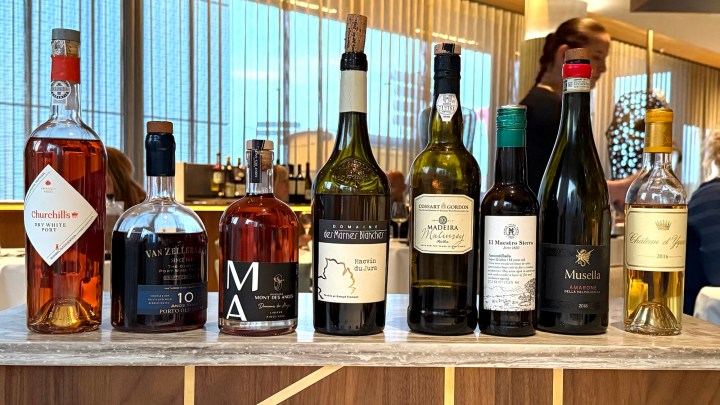
There was also a cart of wines for the cheese, from which we selected the Amarone and adjusted our cheese selection accordingly.

We are picky when it comes to pairing wine and cheese, but we managed to pick some cheeses that worked well with the Amarone.
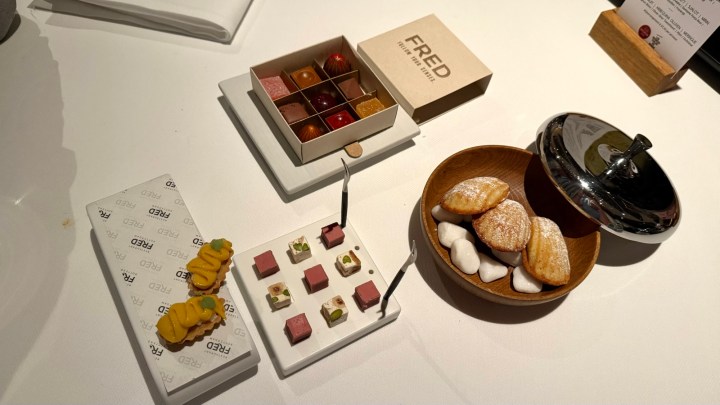
It made sense to have cheese instead of dessert, because coffee or tea was accompanied by a nice set of friandises. It was a nice touch that the bonbons came in a box to take home (which we did). The madeleines were excellent.
According to the restaurant’s website, chef Fred says “My kitchen is based on acids. Citrus fruit in particular makes dishes easy to digest.” We didn’t really notice this. Instead, most of the dishes seemed to have sweet rather than acid elements (mirin in the jus with the Wagyu, the olive on the caviar, watermelon with the shrimp amuse, a sweet cracker with the eel amuse, etc.) Everything was good, but I prefer the food at the two Michelin star restaurants in Amsterdam at a similar (Ciel Bleu) or lower (Spectrum, Vinkeles, 212) price point.
Our star of the evening was sommelier Daniël Gravesteijn. He did not only give us excellent advice, but he was also very attentive. Even though the restaurant was quite busy and he seemed to be handling the wine at all the tables, we never had to wait for anything related to wine. For example, he noticed from the other end of the restaurant that my level of Chassagne was running low while we were having the sea bass, and refilled it before I could even worry about it. He also asked about the temperature of the Chassagne and chilled it a few degrees upon my request. (Restaurant manager Alex Rosier, who is also the other sommelier, was not present. Mirjam Mustert, co-owner and wife of the chef, was present, but in a very modest and friendly way. We did not see the chef in the dining room; I don’t know if he was present in the kitchen.)


Happy Anniversary! Everything looks so beautiful and inviting.
LikeLiked by 1 person
A delightful morning when I am able to join you at the dinner table! Sincere belated congratulations on your anniversary! Although plastics exhibitions and fairs have taken me to Amsterdam and Utrecht on quite a few occasions, have not been to Rotterdam either! ‘Enjoyed’ your mainly fish and seafood meal and my apologies for ‘our’ wagyu not quite measuring up. Like the plating and the fact that the friandises offered came in a box! Like the tables set so far apart and the lovely view on the boats you say Kees enjoys! Just – you speak of ‘dinner’ whilst daylight is streaming in thru’ the window . . ) ?
LikeLiked by 1 person
This time of the year, the sun sets after 10pm!
LikeLiked by 1 person
*huge smile* I wish . . . !
LikeLike
Buon anniversario! Un menu strepitoso
LikeLiked by 1 person